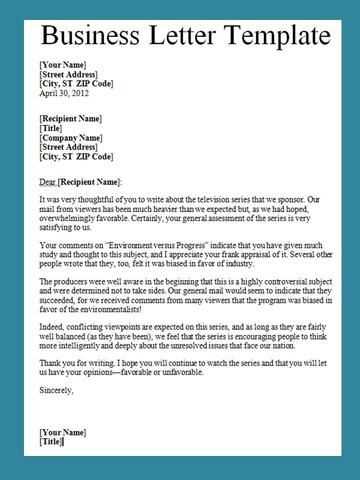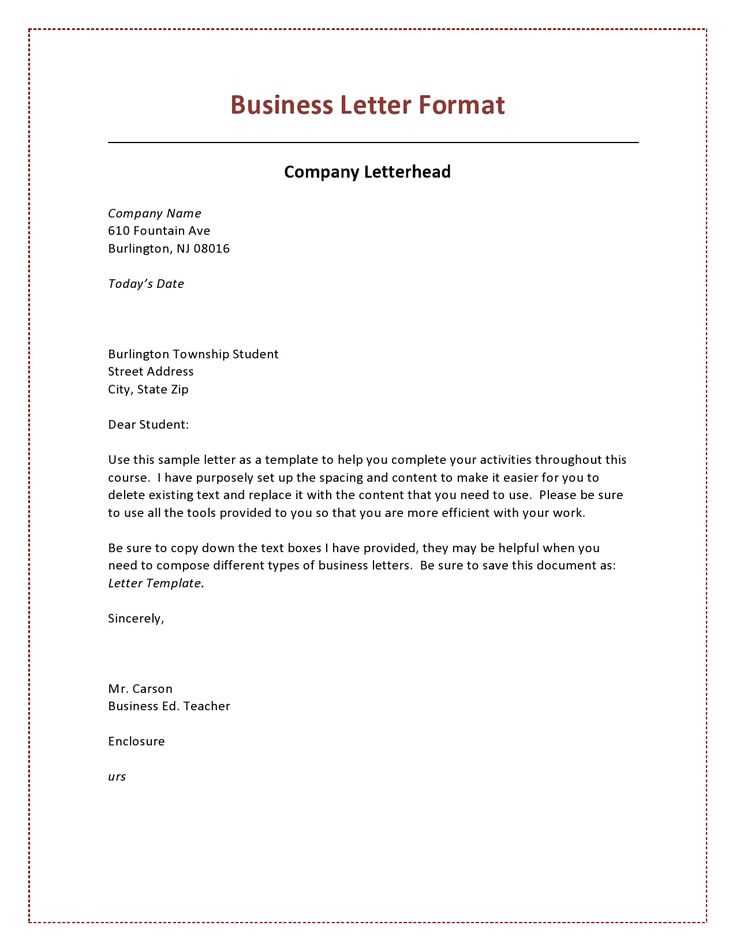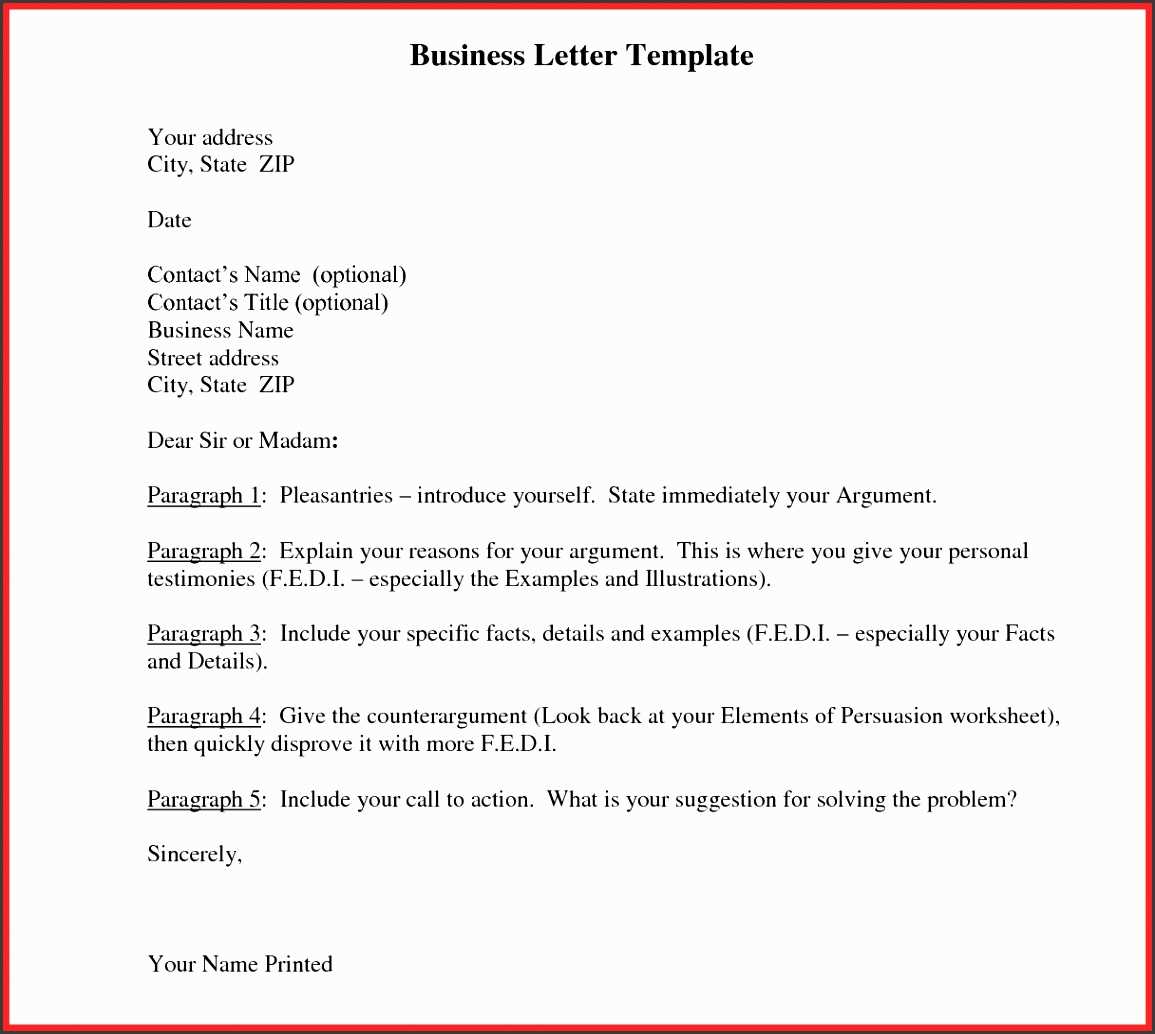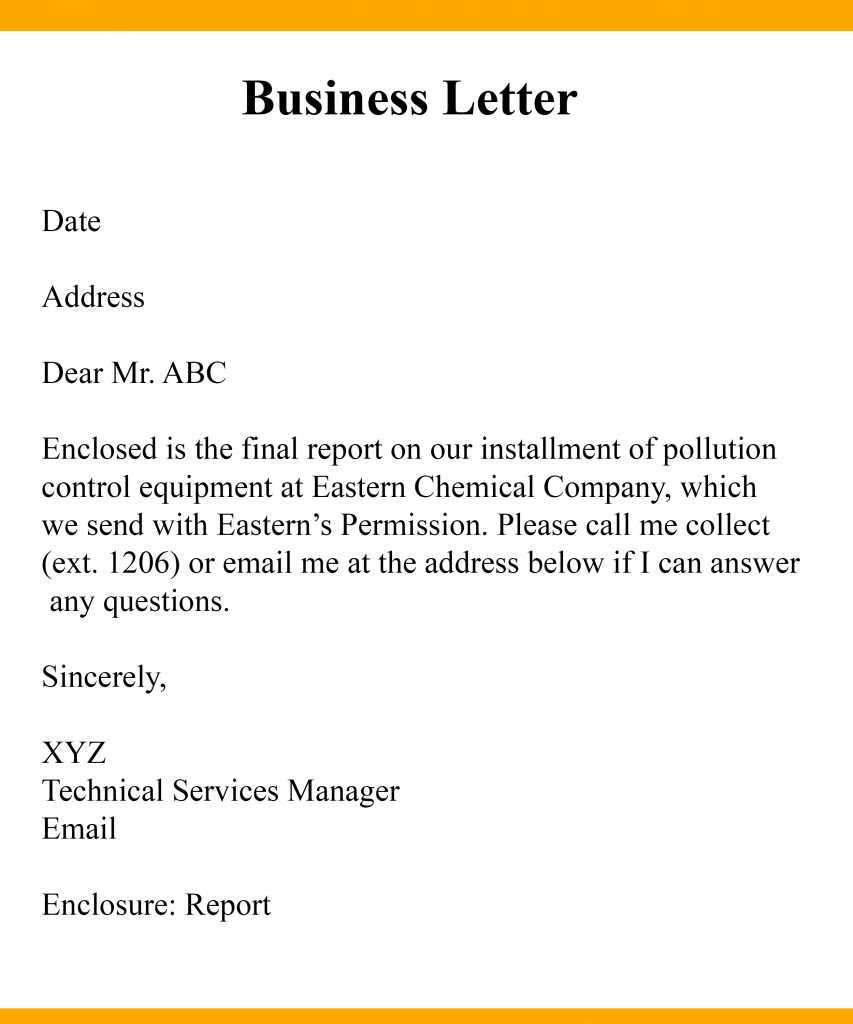Business letter outline template

Use a clear structure when writing a business letter to make a strong impression. A good outline ensures that your message is both concise and easy to follow. This template covers all the key sections to guide you through the process efficiently.
Start with a header, which includes your contact details, the date, and the recipient’s information. A formal salutation follows, setting a respectful tone for the correspondence. Then, the body of the letter is divided into clear sections: an introduction, the main message, and a conclusion. Each part should be focused and direct, ensuring the recipient understands your point quickly.
Finish with a closing and your signature. Be polite and professional in your choice of words, avoiding unnecessary phrases. This outline provides a solid foundation for any business letter, making it easier to communicate effectively.
Business Letter Outline Template
Begin with the sender’s contact information, placed at the top left corner. Include the full name, job title, company name, address, phone number, and email. Ensure this information is accurate and up-to-date.
Next, add the date directly below the sender’s details. Use the full date format (e.g., February 1, 2025). This provides clarity about the letter’s timing.
Then, include the recipient’s contact information, positioned below the date. Include the recipient’s name, job title, company name, and address. Ensure you have the correct name and title to avoid any misunderstandings.
Start the salutation with “Dear [Recipient’s Name],” followed by a comma. If the recipient’s name is unknown, use a generic greeting like “To Whom It May Concern” or “Dear Sir/Madam.” Avoid overly casual greetings in business communication.
For the body of the letter, open with a clear and concise introduction. State the purpose of the letter in the first paragraph. Be direct and focused–avoid unnecessary details.
Use the following paragraphs to expand on the purpose. Address specific points, provide relevant details, and keep the tone professional. Stay organized and logical in your approach.
End the body with a call to action, if necessary. Clearly state what you would like the recipient to do after reading the letter, whether it’s responding to an inquiry, arranging a meeting, or taking other actions.
Conclude with a courteous closing statement, such as “Sincerely,” “Best regards,” or “Yours faithfully.” Ensure your closing is appropriate for the formality of the letter.
Sign your name under the closing statement, leaving space for a handwritten signature if sending a hard copy. Below your signature, type your name and, if applicable, your job title or company name.
Finally, include any enclosures or attachments. Mention them briefly at the end of the letter, such as “Enclosure: Resume” or “Attachment: Report.” This alerts the recipient to additional materials included with the letter.
How to Start Your Business Letter: Essential Elements
Begin with a clear, professional heading that includes your contact information, the date, and the recipient’s details. The top of your letter should have your name, position, company, and address on the left. Below that, add the date, followed by the recipient’s name, position, and company details, aligned to the left as well. Keep this section concise and formal.
After the header, use a polite salutation. Address the recipient with their proper title (e.g., Mr., Ms., Dr.) and last name. If you’re unsure about the recipient’s title, “Dear [First Name] [Last Name]” works for a less formal approach. Avoid generic greetings like “To whom it may concern” unless absolutely necessary.
Next, craft a brief opening statement that clearly outlines the purpose of your letter. Avoid unnecessary pleasantries or vague statements. Be direct: whether you’re addressing a concern, making a request, or introducing a proposal, state your intent right away to maintain clarity and focus.
Structuring the Body: Clear and Concise Communication
Organize your main points into clearly defined sections. Each paragraph should address a specific idea, making it easy for the reader to follow the logic of your message.
Be direct. State the purpose of your communication right away. Avoid unnecessary background details or explanations that don’t contribute to your core message. If the context requires elaboration, make sure it’s brief and relevant to the main point.
Keep your language straightforward. Use simple words and short sentences to convey your message. This avoids confusion and ensures the reader understands quickly. Avoid jargon unless it’s relevant to the audience’s knowledge and directly supports your argument.
Structure your ideas in a logical sequence. If you are presenting a series of actions or steps, list them in a clear, ordered manner. This could be through bullet points or numbered lists to make the information easy to digest.
Be mindful of your tone. Stay polite and professional, even when addressing difficult topics. Ensure your message is clear without being overly blunt or harsh.
If there are multiple sections, separate them with headings. This creates visual breaks in the text and helps the reader navigate through the content quickly.
Use a table when comparing options, detailing specifications, or presenting data. A table helps to display information in a structured, easy-to-read format that enhances clarity. Here’s an example:
| Option | Details | Cost |
|---|---|---|
| Option A | Feature 1, Feature 2 | $200 |
| Option B | Feature 3, Feature 4 | $300 |
Conclude each section with a brief summary or action point, making it clear what steps the reader should take next.
Choosing the Right Tone: Formality and Professionalism
Strike a balance between formality and professionalism based on your audience and purpose. Adjust your tone to suit the recipient’s expectations and the context of your communication.
- Understand your audience: If you’re writing to a senior executive or a formal institution, use a more formal tone. For internal communication or familiar clients, a more relaxed tone can be appropriate without sacrificing professionalism.
- Use polite and respectful language: Regardless of formality, always maintain a respectful tone. Phrases like “I would appreciate,” “Thank you for your time,” and “Please let me know” help convey politeness while keeping the tone professional.
- Avoid slang and overly casual expressions: Even in less formal situations, avoid colloquialisms and slang. Keep language clear and courteous without being too informal.
- Stay concise and clear: Whether formal or informal, a professional tone requires clarity. Use precise language and avoid ambiguity, especially in business letters or official correspondence.
- Maintain consistency: Your tone should remain consistent throughout the letter. Switching between formal and casual may confuse the reader and undermine the professionalism of your message.
By tailoring your tone based on the recipient and the context, you ensure your message is received as intended and enhances your credibility in a professional setting.
Key Considerations for the Closing Section
End with a clear call to action. Whether you’re requesting a response, offering assistance, or prompting the reader to take the next step, make your intent clear. Avoid ambiguity and be specific about what you want them to do next.
Maintain professionalism, but aim for warmth. The closing section sets the tone for future communication. A polite, approachable tone ensures the reader feels valued and encouraged to engage further.
Be concise. Your closing should not introduce new topics but rather summarize the core purpose of the letter. Keep it to a few lines that reinforce your message and provide a clear pathway for follow-up.
Use a courteous sign-off. “Sincerely” and “Best regards” are common choices. However, feel free to adjust based on the level of formality and your relationship with the recipient.
Ensure contact information is easily accessible. If you’re expecting a response, include your phone number, email, or other relevant ways the reader can reach you quickly.
Personalizing Your Letter for Specific Purposes
Begin by identifying the recipient’s role and background. Tailor your tone and content based on whether you’re addressing a colleague, a client, or a potential partner. For instance, a formal tone may be more appropriate for business inquiries, while a friendly tone works better for internal communication.
Adjusting Your Approach
Focus on the specific reason for writing. If your letter is a follow-up to a meeting, reference key discussion points directly to remind the reader of the context. When seeking a partnership or collaboration, highlight mutual benefits and demonstrate how your proposal aligns with the recipient’s objectives.
Customizing the Message
Use the recipient’s name and specific details about your previous interactions to make the letter feel personalized. Mention any particular preferences or requirements they’ve shared with you in the past. This shows that you pay attention to their needs and fosters a stronger connection.
Common Mistakes to Avoid When Writing Business Letters

Use a clear and concise subject line. A vague or missing subject can lead to confusion and delays. Always ensure the recipient knows exactly what the letter is about before opening it.
1. Using Informal Language
Business letters require a formal tone. Avoid slang, contractions, or overly casual phrases. A professional tone conveys respect and establishes authority. For example, instead of “I wanna know,” say “I would like to know.”
2. Failing to Proofread
Typos and grammatical errors damage your credibility. Review the letter multiple times, and if possible, ask a colleague to check it. Errors make your communication appear rushed and unprofessional.
3. Writing Lengthy Paragraphs
Long paragraphs can be overwhelming. Break your content into shorter, more digestible sections. Use bullet points or numbered lists to enhance clarity and structure.
4. Neglecting the Recipient’s Name

Always personalize your letters by addressing the recipient by name. Generic greetings like “Dear Sir/Madam” should be avoided unless absolutely necessary. A personalized greeting shows attention to detail and respect.
5. Using Excessive Jargon
Don’t overcomplicate your message with technical terms or industry jargon. Ensure that anyone reading your letter can understand it. Simplicity promotes better understanding and reduces the risk of miscommunication.
6. Overloading with Information
Stay focused on the main point. Avoid providing excessive background information or unnecessary details. Prioritize what the reader needs to know to take action.
7. Ignoring the Structure

Follow a clear structure in your letter. Start with a proper greeting, introduce your purpose early, and finish with a polite closing. A well-structured letter is easier to follow and makes a more positive impression.
8. Using a Weak Closing
End with a strong, clear closing statement. Avoid ambiguous phrases like “Hope to hear from you soon.” Instead, use assertive closings like “I look forward to your response” or “Please let me know if you need any further information.”